Key takeaways:
- Vintage fashion serves as a reflection of social norms and cultural shifts, telling stories of rebellion, elegance, and history.
- Studying vintage styles enhances appreciation for craftsmanship and inspires conversations about sustainability in modern fashion.
- Key influences on vintage fashion include societal events, like World War II and the cultural movements of the 1960s and 1980s.
- Personal experiences with vintage clothing evoke nostalgia and emotional connections, bridging past generations through shared histories.
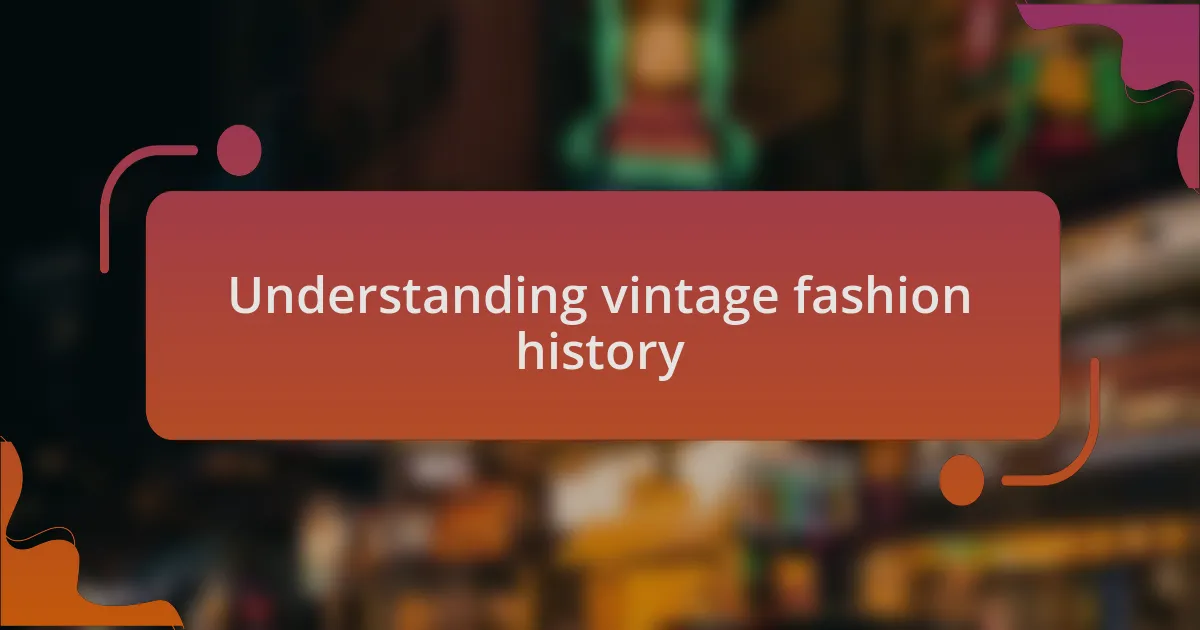
Understanding vintage fashion history
Vintage fashion history is a fascinating window into the past, reflecting the social norms and cultural shifts of different eras. I often find myself marveling at how a simple piece of clothing can tell stories of rebellion, elegance, or even economic turmoil. Have you ever considered why certain styles come back into vogue?
For me, exploring vintage fashion is like stepping into a time machine. I remember the first time I stumbled upon a 1940s tea dress at a thrift store; it felt magical to wear something that had likely seen countless celebrations and dances. Each garment carries a unique history and energy, inviting us to connect with what those who wore it felt and experienced.
As you delve deeper into this world, you’ll find that understanding the craftsmanship behind vintage pieces also illuminates broader societal trends and shifts in technology. For instance, the rise of synthetic fabrics in the 1960s transformed not only how clothes were made but also how they were perceived. Isn’t it intriguing to think about how the clothes we wear today are influenced by what came before?
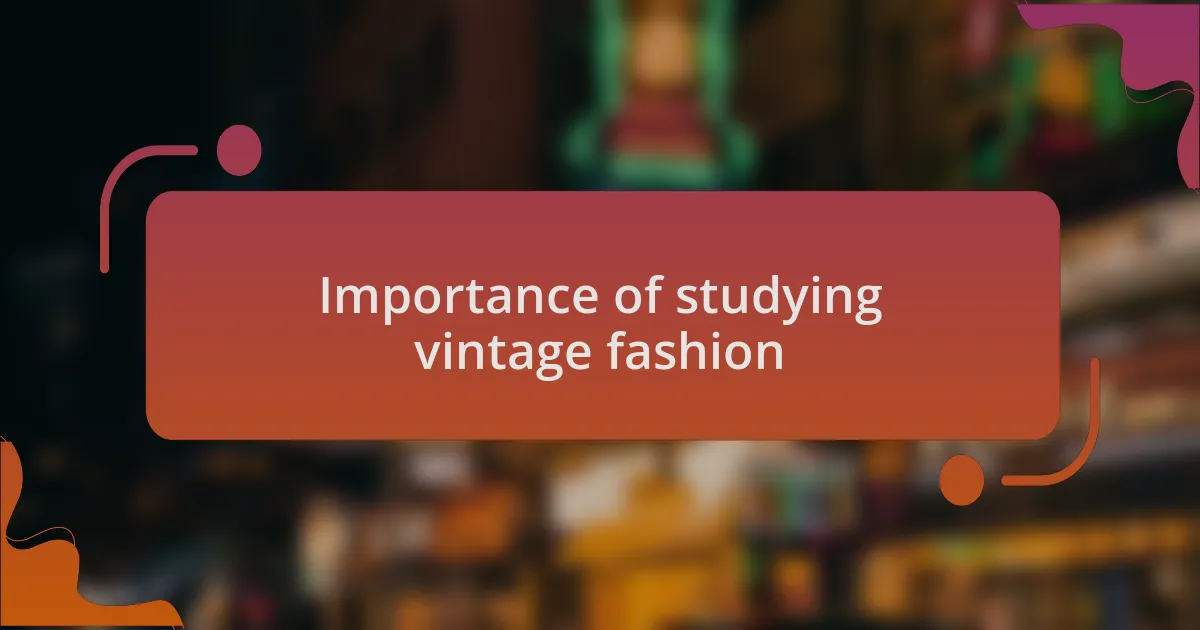
Importance of studying vintage fashion
Studying vintage fashion is crucial because it opens our eyes to the complexities of human expression throughout different periods. When I first learned about the flapper dresses of the 1920s, I felt a surge of admiration for women who defied conventions. Their bold choices were not just about aesthetics; they represented a clash against societal restraints. Doesn’t it make you wonder what stories those dresses could tell if they could speak?
Moreover, understanding vintage fashion allows us to appreciate the artisanship that has been overshadowed by fast fashion. I recall my visit to a local fashion museum where I saw a hand-stitched gown from the 1950s. The care and detail were unmistakable, and it struck me how much love and labor went into creating garments back then. Does this dedication resonate with you the way it does with me?
Finally, examining vintage styles can inspire contemporary fashion choices, urging us to think critically about sustainability. I once revived a classic 1970s ensemble by mixing it with modern pieces, and the compliments were endless! It made me realize that fashion is cyclical, prompting conversations about how we can create beautiful, thoughtful wardrobes today. How might we balance nostalgia with innovation in our own lives?
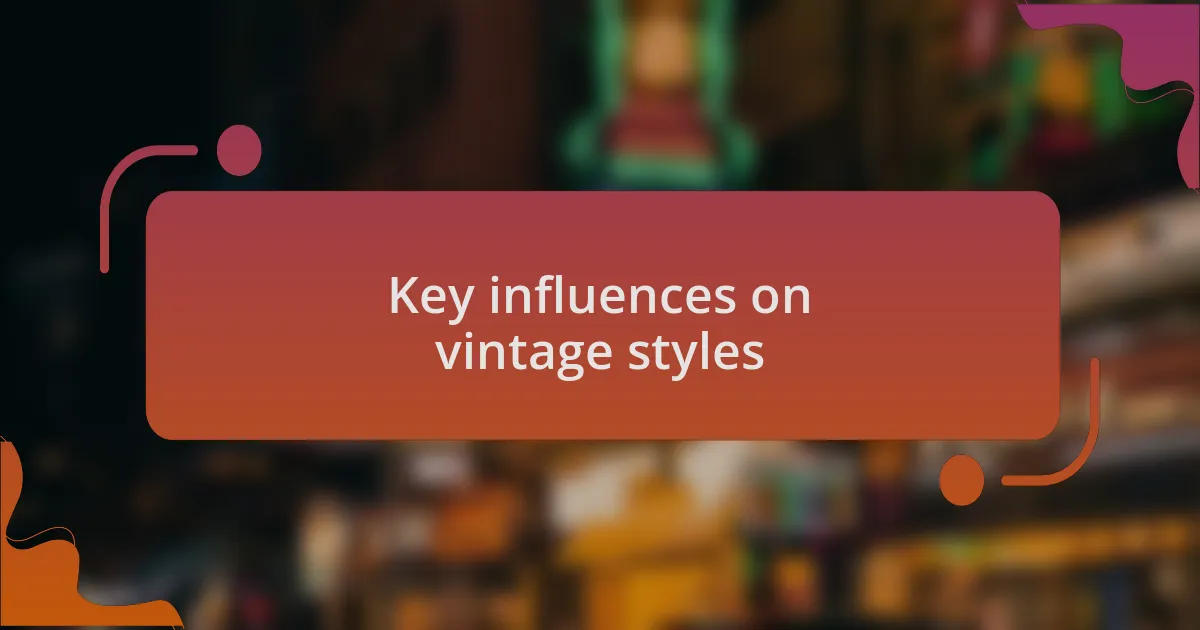
Key influences on vintage styles
Fashion has always been a mirror reflecting the societal attitudes and cultural milestones of its time. For instance, the influence of World War II on styles in the 1940s is undeniable. The practicality of clothing evolved as fabric rations took hold, leading to designs that prioritized utility alongside femininity. When I first discovered this connection, it made me appreciate how external factors shape our aesthetics. Have you ever considered how history manifests in the clothes we wear?
The vibrant colors and bold prints of the 1960s encapsulated a spirit of rebellion and transformation. This era was pivotal, as it embraced the unexpected and celebrated diversity, impacting not just fashion but music and art as well. I’ll never forget flipping through vintage magazines and being inspired by the audacity of mod fashion. It truly made me think: how does our own generation’s style reflect the world around us?
Icons of vintage fashion, like Audrey Hepburn or James Dean, left indelible marks that still influence designers today. Their timeless looks demonstrate the power of personal style in shaping cultural trends. I often find myself drawn to Hepburn’s classic elegance when selecting outfits for special occasions. It raises an interesting question: what style icons resonate with you, and how do they influence your choices?
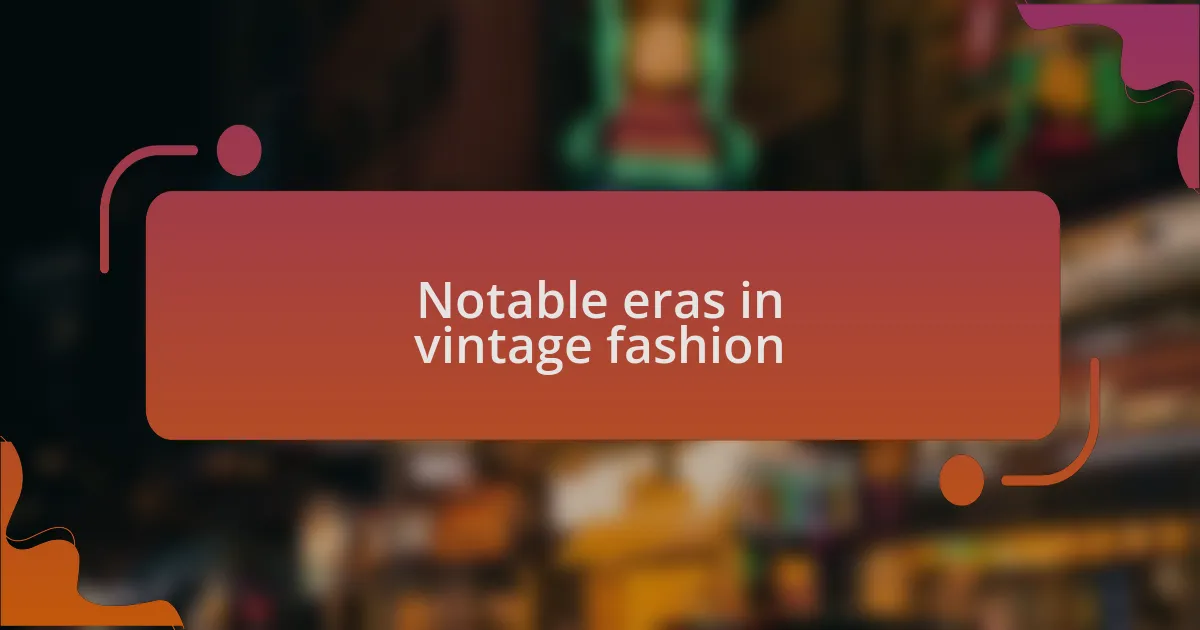
Notable eras in vintage fashion
The 1920s marked a turning point in fashion history, characterized by the flapper style and the liberation of women’s clothing. The shift towards shorter hemlines and looser silhouettes allowed women to express a newfound freedom in movement and lifestyle. I remember the first time I wore a vintage flapper dress to a themed party; it was exhilarating to embody that spirit of rebellion and empowerment.
Moving into the 1970s, we see the rise of bohemian styles, which embraced a carefree and eclectic aesthetic. This era was all about individual expression, blending different cultures and influences. Reflecting on my own experiences, I’ve often found that the vibrant patterns and flowing fabrics of this time resonate with my desire for authenticity and self-discovery. Have you ever felt drawn to a unique piece that just speaks to who you are?
Lastly, the 1980s brought about bold colors, oversized silhouettes, and the influence of music videos and pop culture figures. Fashion became an extension of personality, often fuelled by the iconic styles of artists like Madonna and Prince. I’ve experienced the thrill of wearing bold, statement pieces that echo this era, allowing me to channel that energy whenever I step out. Don’t you find that certain styles can transport you back to a different time, making you feel part of something bigger?
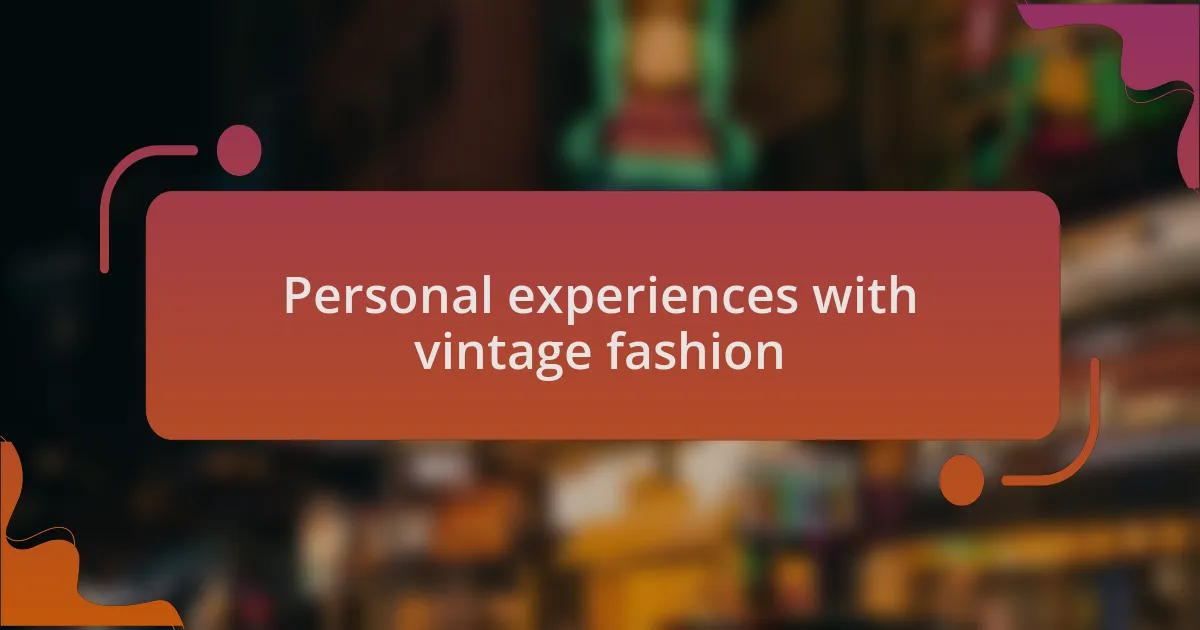
Personal experiences with vintage fashion
Diving into vintage fashion has always felt like a journey through time for me. One memorable experience was at a local flea market where I stumbled upon a beautifully preserved 1940s blouse. As soon as I slipped it on, I couldn’t help but feel a connection to the past. It was as though the fabric held stories, and wearing it made me a part of that narrative. Have you ever found a piece that makes you feel like you’re wearing history?
I recall attending a vintage fashion fair, surrounded by racks of dresses that seemed to whisper secrets of their eras. Trying on a 1960s shift dress filled me with nostalgia for a time I never lived through. The vibrant prints and structure brought a rush of joy, making me feel like a character in a classic film. Isn’t it fascinating how clothing can evoke such strong emotions and memories in us?
Another highlight was when I styled a 1950s full skirt for a friend’s wedding. The way the skirt flowed and twirled with every step felt magical, almost like dancing through the years. The compliments I received were affirming, and I realized how vintage fashion can spark conversations and connections. Don’t you think it’s rewarding to share a piece of history with others while celebrating your unique style?
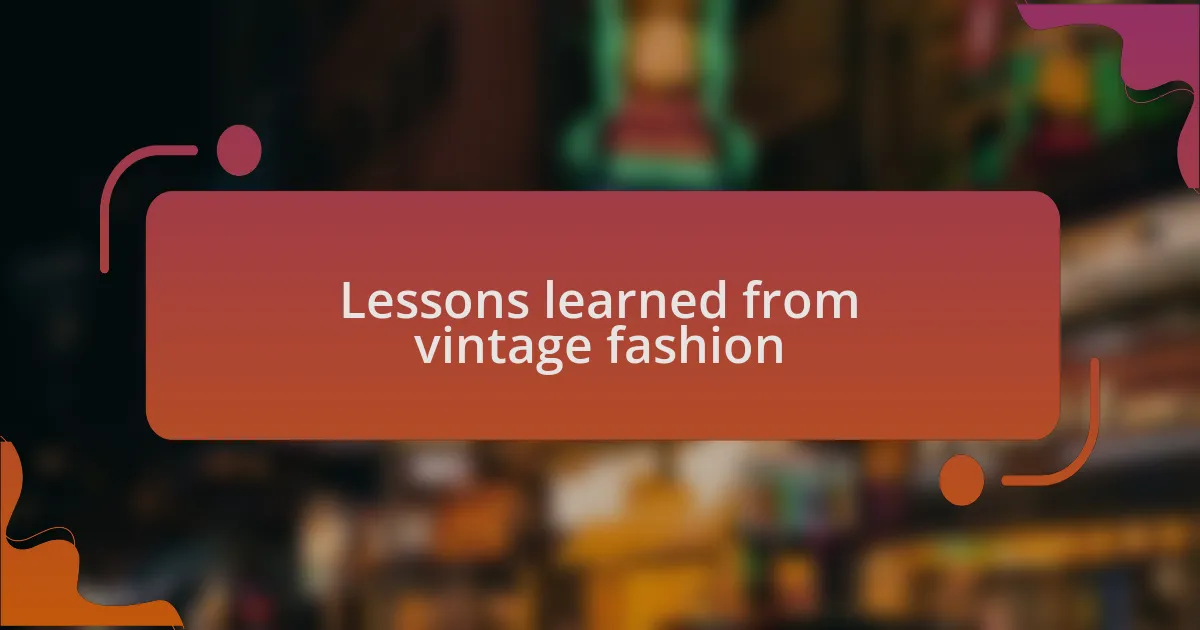
Lessons learned from vintage fashion
Exploring vintage fashion has taught me that each piece carries a unique story shaped by its time. I remember discovering a 1970s bohemian dress at an estate sale, and as I wore it to a summer picnic, I felt the spirit of freedom and creativity that defined that era. Isn’t it remarkable how clothing can reflect the cultural movements and social changes of its time?
One lesson I’ve internalized is the importance of sustainability in fashion. While each vintage piece adds character to my wardrobe, it also serves as a reminder of the importance of repurposing and valuing what already exists. Have you ever thought about how wearing vintage is not just a style choice, but a commitment to reducing waste?
Reflecting on my vintage adventures, I’ve found that these garments often spark conversations that deepen connections with others. I once wore a 1930s dress to a gathering, and a fellow guest shared her grandmother’s tale of flapper dances and speakeasies, enriching my understanding of that time period. Isn’t it fascinating how vintage fashion can bridge generations and create a tapestry of shared history?